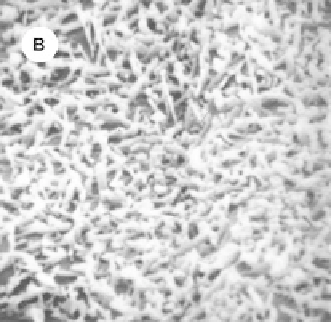Agriculture Reference
In-Depth Information
following spraying, decreased 5-10-fold between the loop and the three-leaf
stage. The contact angle between water and the leaf surface increased from 58°
for the cotyledon, typical of a readily wettable surface, to 125° for leaf three,
typical of a highly water-repellent surface. Scanning electron micrographs of
onion leaf surfaces show the cotyledon to have a smooth surface covered by flat
wax plates, true leaf 1 to be covered in distinct wax crystals and leaf 2 to have a
micro-rough surface of crystalline wax that gives the leaf a visible 'bloom' (see
Fig. 5.5). These changes in surface wax cause the decrease, with plant age, in
surface wettability, the concentration of substances retained after spraying
and, hence, the increase in herbicide tolerance. Where post-emergence
herbicides cannot be applied until the crop has reached a tolerant stage, the
crop needs to be uniformly at the same stage of growth. A prerequisite for this
is a narrow spread of emergence in time, hence the need for good seedbeds and
seedling establishment conditions if herbicides are to be used effectively (see
Chapter 6).
Fig. 5.5.
Scanning electron
micrographs of onion leaf surfaces
(
10,000). (a) Cotyledon where a layer
of flat wax scales overlays the cuticle.
(b) First true leaf with a layer of small,
densely packed wax crystals on the
surface. (c) Second leaf with larger and
more clearly defined wax crystals. The
thinner wax on the first-formed leaves
results in their greater susceptibility to
herbicide (from Verity
et al
., 1981.
Courtesy of
Weed Research
).



